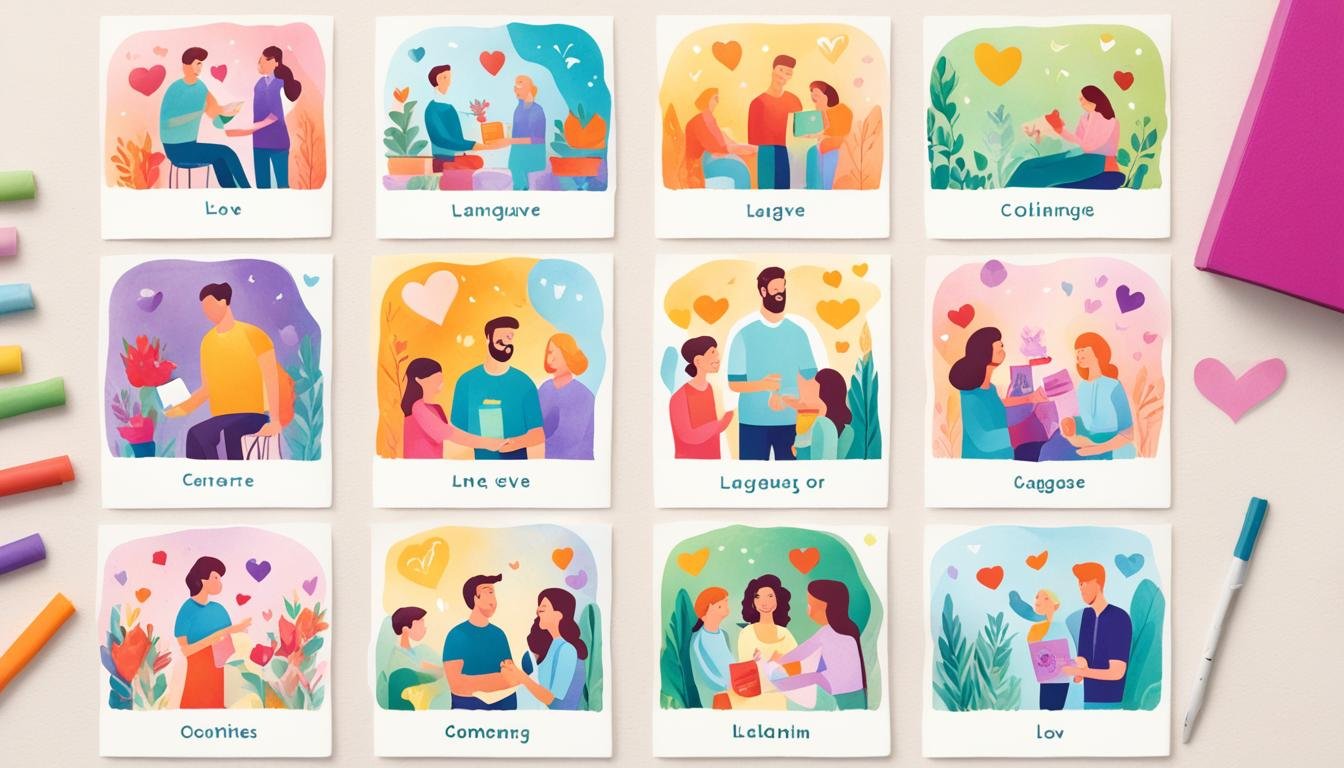Did you know that understanding and utilizing love languages can significantly improve communication and connection in your relationship?

- Love languages refer to the ways people receive and express love in relationships.
- The five primary love languages are words of affirmation, quality time, physical touch, acts of service, and receiving gifts.
- Knowing your own and your partner’s love language can deepen your connection and improve communication.
- Love languages are a tool for understanding and meeting each other’s needs in a relationship.
- Regularly discussing and applying love languages can enhance and strengthen your relationship.
The Origin of Love Languages
In 1992, renowned author and pastor Gary Chapman introduced the concept of love languages in his groundbreaking book, “The 5 Love Languages.” Through his extensive experience counseling couples, Chapman observed that many relationships were plagued by misunderstandings and ineffective communication. He recognized the need to identify the primary love languages individuals use to express and receive love in relationships.
Chapman’s insightful work shed light on the diverse ways people experience and express love, leading to a greater understanding of interpersonal dynamics. By uncovering the primary love languages of individuals, couples can bridge the gap between their needs and effectively communicate their affection.
Chapman’s research and extensive work in the field of relationships have provided invaluable insights into the development of love languages and how they can foster healthier and more fulfilling partnerships. Let’s delve into the five primary love languages and explore how they play a pivotal role in romantic connections.
Stay tuned for the next section where we will dive deeper into the first love language: Words of Affirmation.
Words of Affirmation: Expressing Love Through Kind Words
Words of affirmation is a love language that involves expressing affection through spoken words, praise, and appreciation. People with this love language value kind words, encouragement, and compliments. They feel most loved when they receive verbal expressions of affection, such as love notes or compliments on their accomplishments.
If your partner’s primary love language is words of affirmation, it’s essential to regularly express your feelings and appreciation towards them. Here are some ways to incorporate words of affirmation into your relationship:
- Offer genuine compliments: Take the time to notice and acknowledge the positive qualities and actions of your partner. Compliment their physical appearance, personal achievements, or even their efforts in household chores.
- Express gratitude: Show gratitude for the little things they do for you. Thank them for their support, gestures of kindness, and the love they bring into your life.
- Send love notes: Surprise your partner with handwritten love notes or heartfelt messages expressing your love and admiration. Leave these notes in unexpected places, like their wallet, on the bathroom mirror, or in their lunchbox.
- Share uplifting quotes: Find and share uplifting and inspiring quotes that resonate with your partner. These words of wisdom can provide comfort, encouragement, and a reminder of your love.
Remember, the key to effective words of affirmation is authenticity and sincerity. When expressing your love, let your partner know how they make you feel and the positive impact they have on your life. By incorporating words of affirmation into your relationship, you can create a stronger emotional connection and make your partner feel deeply loved and valued.
“Kind words can be short and easy to speak, but their echoes are truly endless.” – Mother Teresa
| Benefits of Words of Affirmation | Examples |
|---|---|
| Boosts self-esteem and confidence | “You are incredibly talented and capable. I believe in you.” |
| Strengthens emotional bond | “Your support means the world to me. I’m lucky to have you by my side.” |
| Creates a positive atmosphere | “Your laughter brightens my day. I love hearing you laugh.” |
| Improves communication | “I appreciate how you always listen and understand me.” |
Quality Time: The Importance of Being Present
Quality time is a love language that focuses on being present and engaged with your partner. It goes beyond mere physical presence and involves giving them your undivided attention and spending time together in meaningful and interactive ways. For those whose primary love language is quality time, this undivided attention is crucial in making them feel loved and valued.
To demonstrate the significance of quality time, imagine a scenario where a couple spends every evening together, but one of them is constantly browsing their phone or watching television instead of actively engaging with their partner. Despite the physical proximity, this lack of meaningful interaction may result in the partner feeling neglected and unloved.
Meaningful interactions during quality time can vary depending on the couple’s preferences, but it often involves activities that foster connection and build shared experiences. This could include engaging in intellectual conversations, going for walks or hikes, participating in enjoyable hobbies, or traveling together.
Having undivided attention means being fully present in the moment with your partner. When spending quality time together, prioritize setting aside distractions and creating an environment where both partners can feel heard and understood. Active listening is a critical component of quality time, allowing partners to truly connect on a deeper level.
For example, instead of merely talking about surface-level topics, active listening involves being attentive to your partner’s needs, emotions, and desires. It requires observing non-verbal cues, asking thoughtful questions, and responding with empathy and understanding.
Physical Touch: Love Through Physical Affection
Physical touch is a powerful love language that speaks volumes without words. It involves expressing love and affection through various physical gestures and acts of intimacy. For individuals with this love language, physical touch is essential to feeling connected and loved by their partner.
There are many ways to express physical touch and nurture your partner’s need for affectionate contact. From holding hands to cuddling to gentle caresses, these affectionate gestures convey love and create a sense of emotional closeness. Embracing your partner in a warm hug, for example, can provide comfort and reassurance during both joyful and challenging times.
When you engage in physical touch, you are not only meeting your partner’s emotional needs but also strengthening the bond between you. Regular physical intimacy helps release oxytocin, known as the “love hormone,” which enhances feelings of trust, security, and connectedness.
“Physical touch is a love language that bridges emotional gaps and fosters deeper intimacy in relationships.”
Physical touch is not limited to intimate moments; it can also be present in everyday activities. Holding hands while taking a walk, playfully rubbing your partner’s back, or offering a comforting touch when they are upset all contribute to the emotional well-being and satisfaction of individuals with a physical touch love language.
, we can depict a couple holding hands or engaging in a warm embrace. This image captures the essence of physical touch as a key component of expressing love and nurturing emotional connections.
In conclusion, physical touch plays a vital role in expressing love and strengthening relationships. By understanding and actively incorporating physical touch into your interactions, you can create a deeper emotional bond and meet the needs of your partner in a profound and meaningful way.
Acts of Service: Showing Love Through Actions
Acts of service is a powerful love language that allows partners to demonstrate their love through helpful actions and gestures. By performing tasks, running errands, or providing support in practical ways, you can show your partner how much you care. For individuals with this love language, thoughtful gestures and acts of service speak louder than words.
Helping your partner with their daily responsibilities can make a significant impact on their well-being and deepen the bond between you. Whether it’s cooking a delicious meal, doing household chores, or taking care of their to-do list, acts of service show your commitment and dedication to their happiness.
“Love is not just about saying ‘I love you,’ but also about showing it through your actions.”
Performing tasks to create a harmonious environment
Performing acts of service can help create a harmonious living environment for you and your partner. By taking the initiative to complete tasks and fulfill responsibilities, you alleviate their stress and contribute to a smoother daily routine. This gesture of support communicates that you value their well-being and are willing to go the extra mile to make their life easier.
For example, taking care of household chores, such as doing the laundry, cleaning the house, or taking care of the lawn, can free up time for your partner to relax or pursue activities they enjoy. Small acts of service can have a significant impact on their overall happiness and the quality of your relationship.
Thoughful gestures that show your love
Acts of service can also take the form of small, thoughtful gestures that demonstrate your love and consideration. From surprising your partner with their favorite treat to running errands on their behalf, these actions show that you pay attention to their needs and are willing to take action to make their day better.
In the hectic pace of life, acts of service provide a source of support and reassurance. They let your partner know that they can rely on you and that you have their best interests at heart. By consistently demonstrating your love through action, you reinforce the foundation of trust and commitment in your relationship.
| Examples of Acts of Service | Benefits |
|---|---|
| Helping with household chores | Reduces stress and creates a harmonious environment |
| Taking care of errands or tasks | Frees up time for your partner to relax or pursue hobbies |
| Preparing a meal or bringing breakfast in bed | Showcases thoughtfulness and dedication |
| Supporting your partner during a difficult time | Strengthens emotional bonds and provides reassurance |
Incorporating acts of service into your relationship can have a transformative effect on both partners. It fosters a sense of partnership and teamwork, where each person feels valued and supported. By actively showing your love through practical actions, you create a solid foundation for a fulfilling and lasting relationship.
Receiving Gifts: Symbolic Expressions of Love
Receiving gifts is more than just a superficial act; it is a love language that values the thoughtfulness and meaning behind each present. It’s not about the cost or size of the gifts, but the genuine effort and consideration that goes into selecting them. For individuals whose primary love language is receiving gifts, these symbolic gestures hold great significance and convey profound emotions.
When someone with this love language receives a gift, they feel deeply appreciated and loved. It reassures them that their partner understands and recognizes their desires and preferences. It’s the thought behind the present that truly matters and makes them feel cherished.
Receiving a thoughtful gift can touch someone’s heart in ways that words sometimes cannot. It demonstrates thoughtfulness, attention to detail, and a clear understanding of the recipient’s desires and interests. It shows that their partner has taken the time to consider their needs and desires, making them feel valued and appreciated.
Gifts are not merely objects but symbolic expressions of love and thoughtfulness.” – Gary Chapman
Symbolism is an essential aspect of this love language. Each gift represents more than the item itself; it embodies the care, thought, and love behind it. It becomes a tangible reminder of the relationship and the emotional connection shared between partners.
It’s important to note that the significance of the gift lies in its thoughtfulness rather than its material value. Whether it’s a handwritten letter, a personalized item, or a small token of appreciation, it’s the sentiment that counts. The receiver perceives each gesture as a meaningful expression of love and thought, strengthening the bond between partners.
When partners prioritize giving and receiving thoughtful presents, it creates an atmosphere of appreciation and thoughtfulness within the relationship. It fosters a deeper emotional connection and enhances the overall relationship satisfaction.
To showcase the impact of meaningful gestures in a relationship, let’s take a look at the following table:
| Benefits of Receiving Gifts as a Love Language | Benefits |
|---|---|
| 1. Expression of thoughtfulness and consideration | The recipient feels understood and valued. |
| 2. Tangible reminders of love and appreciation | Gifts serve as lasting symbols of the relationship. |
| 3. Strengthened emotional connection | Each gift deepens the bond and reinforces love. |
| 4. Increased relationship satisfaction | Both partners feel more fulfilled and appreciated. |
It’s important to remember that love languages can vary from person to person, and individuals can have a primary love language along with secondary ones. Understanding and appreciating your partner’s love language is crucial for building a strong and lasting relationship.

Additional Love Languages and Frameworks
While the original five love languages remain the same, there have been proposed additions over the years that further explore the complex nature of human connection and emotional expression. These additional love languages and frameworks provide valuable insights into the multiple ways we can express and receive love.
Shared Experiences: Creating Bonds Through Moments
One of the additional love languages is shared experiences. It recognizes the importance of creating meaningful moments and memories together as a way to strengthen the bond between partners. By engaging in activities, adventures, and shared hobbies, couples can nurture their connection and create a foundation of cherished experiences.
Emotional Security: Building Trust and Support
Another proposed addition to the love languages is emotional security. It focuses on the need for trust, vulnerability, and emotional support within a relationship. Emotional security involves creating a safe and nurturing environment where both partners can feel secure in expressing their emotions and seeking comfort and understanding.
These additional love languages provide a broader perspective on the ways we can express love and meet our partner’s needs. By understanding and incorporating these frameworks into our relationships, we can deepen our emotional connection and create a more fulfilling and harmonious partnership.
Understanding and embracing the concept of additional love languages expands our awareness of the diverse ways we can express affection and strengthen our relationships. It reminds us that love is multifaceted and that there are multiple avenues for emotional connection and fulfillment.
Identifying Your Love Language
Discovering your love language and your partner’s love language can provide valuable insights into how you both give and receive love. There are various methods you can use to identify your love language and recognize your partner’s love language. One popular option is to take a love language quiz, which can help you determine your primary love language.
You can also reflect on your own behaviors and preferences when it comes to expressing love and asking for love in your relationship. Consider the ways you naturally show affection, as well as the actions and gestures that make you feel loved and appreciated. By observing these patterns, you can gain a better understanding of your love language.
“Love is not just a set of emotions; it is a way of life that requires understanding, empathy, and effective communication.”
Additionally, pay attention to your partner’s behaviors and how they express love. Notice the things they do that make you feel most loved and cherished. This can give you clues about their primary love language. Remember, everyone has a unique way of expressing and receiving love, so it’s important to be observant and open to understanding your partner’s love language.
Identifying your love language and your partner’s love language is a journey of self-discovery and exploration. It requires patience, open communication, and a willingness to learn about each other’s emotional needs. By recognizing and understanding each other’s love languages, you can create a stronger and more fulfilling bond in your relationship.
Key Takeaways:
- Take a love language quiz to help identify your primary love language.
- Reflect on the ways you ask for love and express love in your relationship to gain insights into your love language.
- Observe your partner’s behaviors and actions to recognize their love language.
- Be patient, communicate openly, and be willing to learn about each other’s emotional needs.
Now that you have a better understanding of how to identify your love language and your partner’s love language, let’s explore the benefits of knowing and using love languages in your relationship.
Benefits of Knowing and Using Love Languages
Understanding and utilizing love languages in your relationship can have numerous benefits that contribute to improving overall relationship satisfaction, emotional intelligence, and deepening intimacy. By actively incorporating love languages into your interactions, you can nurture a stronger connection with your partner and create a more fulfilling relationship.
Focus on Each Other’s Needs
By understanding your partner’s love language and communicating in a way that aligns with it, you can prioritize their needs and make them feel truly valued. This focus on meeting each other’s needs fosters a sense of harmony and mutual fulfillment in the relationship.
Improved Communication
Love languages provide a framework for effective communication within a relationship. When you speak your partner’s love language, it ensures that your message of love is understood and received by them in the most meaningful way. This leads to clearer and more successful interactions, reducing misunderstandings and promoting a stronger emotional connection.
“Love languages provide a framework for effective communication within a relationship.”
Enhanced Emotional Intelligence
By learning and applying the concept of love languages, you develop a deeper understanding of emotions and emotional needs. This increased emotional intelligence allows you to better recognize and respond to your partner’s feelings, fostering empathy, and creating an environment of emotional safety and support.
Deepening Intimacy and Connection
Love languages serve as a pathway to deepening intimacy and connection in your relationship. By consistently expressing love in the ways that resonate most with your partner, you create a strong emotional bond and a heightened sense of closeness. This emotional intimacy helps build trust, vulnerability, and a lasting sense of partnership.
Challenges and Limitations of Love Languages
While love languages can be beneficial for enhancing communication and understanding in relationships, it’s important to be aware of their challenges and limitations. By recognizing these potential pitfalls, you can navigate love languages effectively and avoid negative dynamics within your relationship.
Avoiding Competition
One limitation of love languages is the potential for competition. When individuals have different primary love languages, they may unintentionally compete for their preferred expressions of love. This can create a sense of rivalry or resentment, undermining the intended purpose of love languages. To overcome this, it’s crucial to approach love languages as an opportunity to learn about each other’s unique needs, rather than engaging in a contest to receive more love or attention.
Avoiding Control and Manipulation
Another challenge is the misuse of love languages as a means of control or manipulation. Love languages should be used to foster genuine connection, understanding, and affection. However, if one partner uses their knowledge of the other’s love language to manipulate or influence their behavior, it can lead to unhealthy dynamics in the relationship. It’s essential to approach love languages with sincerity and authenticity, ensuring they are used to enhance, rather than control, the relationship.
Flexibility and Adaptability
Love languages provide a framework for understanding and expressing love, but it’s crucial to remember that they are not a one-size-fits-all solution. People are complex, and their needs may change over time. Being flexible and adaptable in your approach to love languages is essential. This means being open to exploring new ways of connecting and meeting your partner’s changing needs. It also involves actively listening and communicating with your partner to ensure that your love languages continue to serve as a tool for deepening your connection.
“Love languages should be used to enhance communication and understanding, not to create negative dynamics in the relationship.”
Understanding the challenges and limitations of love languages allows you to approach them with mindfulness and intention. By avoiding competition, control, and manipulation, and maintaining flexibility and adaptability, you can harness the power of love languages to deepen your connection and build a healthier, more fulfilling relationship.
| Challenges | Solutions |
|---|---|
| Avoiding Competition | Approach love languages as a means to learn about each other’s unique needs and avoid competing for expressions of love. |
| Avoiding Control and Manipulation | Use love languages sincerely and authentically to foster genuine connection, rather than as a means to control or manipulate your partner. |
| Flexibility and Adaptability | Be open to exploring new ways of meeting your partner’s changing needs and actively communicate to ensure your love languages continue to deepen your connection. |
Conclusion
Understanding and utilizing love languages can have a profound impact on improving relationships. By recognizing and appreciating the different ways people give and receive love, effective communication can be established, leading to a deeper understanding of your partner.
By taking the time to identify your own and your partner’s love language, you can meet each other’s needs more effectively. This not only enhances emotional connection but also builds a stronger and more fulfilling relationship.
Through the use of love languages, couples can develop effective communication strategies that prioritize the specific ways they feel loved and valued. By implementing these strategies, relationships can flourish and grow, fostering a deeper sense of intimacy and emotional well-being.
FAQ
What are love languages?
Who developed the concept of love languages?
How can love languages improve communication in relationships?
What is the origin of love languages?
What is the love language of words of affirmation?
How does quality time fit into love languages?
What is the love language of physical touch?
How does acts of service contribute to love languages?
What does receiving gifts mean as a love language?
Are there any additional love languages beyond the original five?
How can I identify my love language and my partner’s love language?
What are the benefits of knowing and using love languages?
What are the challenges and limitations of love languages?
Source Links
- https://www.loveisrespect.org/resources/applying-the-5-love-languages-to-healthy-relationships/
- https://www.verywellmind.com/can-the-five-love-languages-help-your-relationship-4783538
- https://bayareacbtcenter.com/5-love-languages-understanding-and-expressing-love-in-relationships/








GIPHY App Key not set. Please check settings